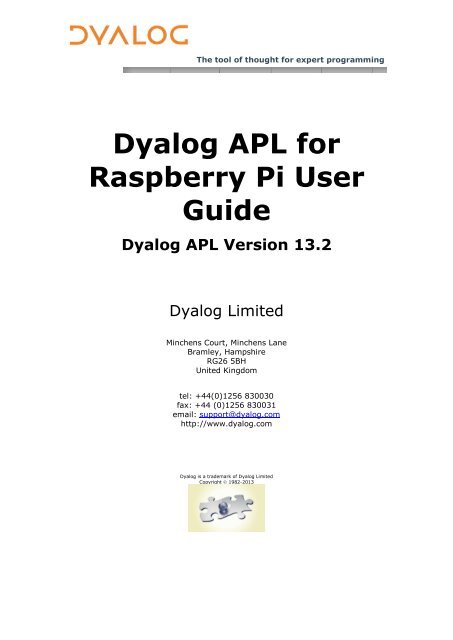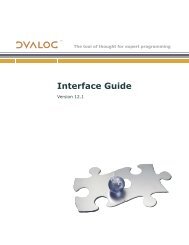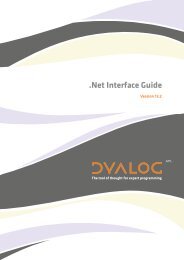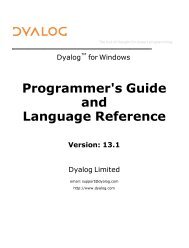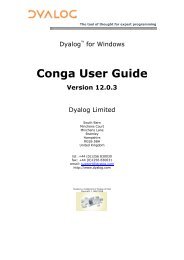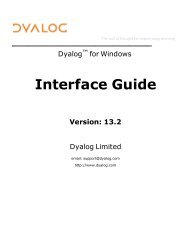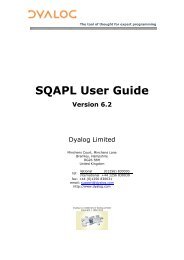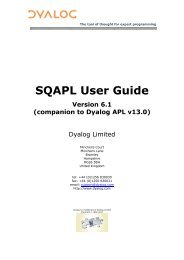Dyalog APL for Raspberry Pi User Guide - Dyalog Limited
Dyalog APL for Raspberry Pi User Guide - Dyalog Limited
Dyalog APL for Raspberry Pi User Guide - Dyalog Limited
Create successful ePaper yourself
Turn your PDF publications into a flip-book with our unique Google optimized e-Paper software.
The tool of thought <strong>for</strong> expert programming<strong>Dyalog</strong> <strong>APL</strong> <strong>for</strong><strong>Raspberry</strong> <strong>Pi</strong> <strong>User</strong><strong>Guide</strong><strong>Dyalog</strong> <strong>APL</strong> Version 13.2<strong>Dyalog</strong> <strong>Limited</strong>Minchens Court, Minchens LaneBramley, HampshireRG26 5BHUnited Kingdomtel: +44(0)1256 830030fax: +44 (0)1256 830031email: support@dyalog.comhttp://www.dyalog.com<strong>Dyalog</strong> is a trademark of <strong>Dyalog</strong> <strong>Limited</strong>Copyright 1982-2013
Copyright 2013 by <strong>Dyalog</strong> <strong>Limited</strong>.All rights reserved.Version 13.2First Edition May 2013No part of this publication may be reproduced in any <strong>for</strong>m by any means without theprior written permission of <strong>Dyalog</strong> <strong>Limited</strong>, Minchens Court,Minchens Lane, Bramley, Hampshire, RG26 5BH, United Kingdom.<strong>Dyalog</strong> <strong>Limited</strong> makes no representations or warranties with respect to the contentshereof and specifically disclaims any implied warranties of merchantability or fitness <strong>for</strong>any particular purpose. <strong>Dyalog</strong> <strong>Limited</strong> reserves the right to revise this publicationwithout notification.All other trademarks and copyrights are acknowledged.
Contents1 ABOUT THIS DOCUMENT .............................................................. 11.1 Audience ........................................................................................................... 12 INTRODUCTION .......................................................................... 23 GE TTING STARTE D ...................................................................... 33.1 Pre-requisites .................................................................................................... 33.2 Installing <strong>Dyalog</strong> <strong>APL</strong> on the <strong>Raspberry</strong> <strong>Pi</strong> ......................................................... 33.3 Upgrading <strong>Dyalog</strong> <strong>APL</strong> on the <strong>Raspberry</strong> <strong>Pi</strong> ...................................................... 43.4 Uninstalling <strong>Dyalog</strong> <strong>APL</strong> from the <strong>Raspberry</strong> <strong>Pi</strong> ................................................ 44 DYALOG <strong>APL</strong> ON THE RA SPBERRY PI .............................................. 54.1 Initialising <strong>Dyalog</strong> <strong>APL</strong> on the <strong>Raspberry</strong> <strong>Pi</strong> ....................................................... 54.2 Configuring <strong>Dyalog</strong> <strong>APL</strong> on the <strong>Raspberry</strong> <strong>Pi</strong> ..................................................... 54.2.1 Configuring the Font Set ........................................................................ 54.2.2 Changing the Background Colour .......................................................... 64.2.3 Changing the Colours <strong>for</strong> Syntax Colouring ........................................... 74.3 Using <strong>Dyalog</strong> <strong>APL</strong> on the <strong>Raspberry</strong> <strong>Pi</strong> .............................................................. 84.3.1 get_started ............................................................................................ 84.3.2 <strong>APL</strong>Keys .................................................................................................. 84.3.3 workspaces ............................................................................................ 94.3.4 references .............................................................................................. 94.4 Logging the Session ........................................................................................... 95 STARTING WITH DYALOG <strong>APL</strong> ..................................................... 10APPENDIX A USE FUL RESOURCES .............................................. 11APPENDIX B LINUX KEYBOARD MAPPI NGS ................................. 12APPENDIX C EXAMPLE CODE .................................................... 13C.1 Morse Code ..................................................................................................... 13C.2 Average Dice Throw Values............................................................................. 14
<strong>Dyalog</strong> <strong>APL</strong> <strong>for</strong> <strong>Raspberry</strong> <strong>Pi</strong> <strong>User</strong> <strong>Guide</strong>1 About This Document1.1 AudienceThis document is intended <strong>for</strong> anyone who wants to run <strong>Dyalog</strong> <strong>APL</strong> on a <strong>Raspberry</strong><strong>Pi</strong>.This document does not provide in<strong>for</strong>mation on the <strong>Raspberry</strong> <strong>Pi</strong> or <strong>Dyalog</strong> <strong>APL</strong> –in<strong>for</strong>mation and documentation <strong>for</strong> these products can be downloaded fromhttp://www.raspberrypi.org/ and http://docs.dyalog.com/ respectively.The in<strong>for</strong>mation provided in this document supplements that given in the <strong>Dyalog</strong><strong>APL</strong> <strong>for</strong> UNIX Installation and <strong>User</strong> <strong>Guide</strong> (available to download fromhttp://docs.dyalog.com). In cases where the in<strong>for</strong>mation given is different betweenthe two documents, this document should be regarded as the definitive source <strong>for</strong><strong>Dyalog</strong> <strong>APL</strong> on the <strong>Raspberry</strong> <strong>Pi</strong>.It is assumed that the reader has a basic understanding of Linux on the <strong>Raspberry</strong> <strong>Pi</strong>.No prior knowledge of <strong>Dyalog</strong> <strong>APL</strong> is required.For those who are new to <strong>Dyalog</strong> <strong>APL</strong>, some guidance on resources that can helpwith getting started are included in Chapter 5.
<strong>Dyalog</strong> <strong>APL</strong> <strong>for</strong> <strong>Raspberry</strong> <strong>Pi</strong> <strong>User</strong> <strong>Guide</strong> 22 Introduction<strong>Dyalog</strong> <strong>APL</strong> – the tool of thought <strong>for</strong> expert programming – is often used in researchand business applications where it is important to integrate domain experts in thesoftware development process. One of the reasons why <strong>Dyalog</strong> <strong>APL</strong> is selected isthat applications written using <strong>Dyalog</strong> <strong>APL</strong> often out-per<strong>for</strong>m and outscalecompeting products written using compiled languages, even though compiled codeshould theoretically out-per<strong>for</strong>m interpreted code. <strong>Dyalog</strong> <strong>APL</strong>, the only <strong>APL</strong>interpreter <strong>for</strong> the <strong>Raspberry</strong> <strong>Pi</strong>, allows the benefits of <strong>APL</strong> to be leveraged on the<strong>Raspberry</strong> <strong>Pi</strong> by bringing the concise, expressive power and per<strong>for</strong>mance of <strong>Dyalog</strong><strong>APL</strong> to the compact, credit-card sized <strong>Raspberry</strong> <strong>Pi</strong> computer.With the appropriate sensors and attachments, <strong>Dyalog</strong> <strong>APL</strong> can turn the <strong>Raspberry</strong><strong>Pi</strong> into much more than a computer, <strong>for</strong> example, a temperature monitor, aproximity indicator or a robot. The progress of a robot being developed at <strong>Dyalog</strong>can be monitored through the following blogs:<strong>Dyalog</strong> developer blog: http://www.jasonrivers.co.uk/category/dyalog/includes in<strong>for</strong>mation on how to replicate the robot’s hardware<strong>Dyalog</strong> CTO blog: http://cto.dyalog.com/category/robots/Some examples of code written <strong>for</strong> the <strong>Raspberry</strong> <strong>Pi</strong> using <strong>Dyalog</strong> <strong>APL</strong> are includedin Appendix C.The licence <strong>for</strong> <strong>Dyalog</strong> <strong>APL</strong> on the <strong>Raspberry</strong> <strong>Pi</strong> is <strong>for</strong> non-commercial use only. Tolicense <strong>Dyalog</strong> <strong>APL</strong> on the <strong>Raspberry</strong> <strong>Pi</strong> <strong>for</strong> commercial use, please contactsales@dyalog.com.
<strong>Dyalog</strong> <strong>APL</strong> <strong>for</strong> <strong>Raspberry</strong> <strong>Pi</strong> <strong>User</strong> <strong>Guide</strong> 33 Getting StartedThis chapter covers the system requirements and installation in<strong>for</strong>mation <strong>for</strong>installing 32-bit Unicode <strong>Dyalog</strong> <strong>APL</strong> on the <strong>Raspberry</strong> <strong>Pi</strong>, as well as the in<strong>for</strong>mationneeded to upgrade or remove an installation.3.1 Pre-requisites<strong>Dyalog</strong> <strong>APL</strong> can be installed and run on the following <strong>Raspberry</strong> <strong>Pi</strong> versions:Model A (256 MB RAM)Model B1 (256 MB RAM)Model B2 (512 MB RAM)This document assumes that one of these <strong>Raspberry</strong> <strong>Pi</strong> versions is available and thatit has at least 100 MB available in the root file system <strong>for</strong> the installation of <strong>Dyalog</strong><strong>APL</strong> – another 100 MB is also required temporarily <strong>for</strong> the installation image.The instructions in this document assume that the <strong>Raspberry</strong> <strong>Pi</strong> is running a Debian(or Debian-based, <strong>for</strong> example, Raspbian) operating system.3.2 Installing <strong>Dyalog</strong> <strong>APL</strong> on the <strong>Raspberry</strong> <strong>Pi</strong>The in<strong>for</strong>mation in this section is also available at http://packages.dyalog.com/.To install <strong>Dyalog</strong> <strong>APL</strong> on the <strong>Raspberry</strong> <strong>Pi</strong>:1. Open a terminal window and log in as the root user – change to the rootuser with the following command:$ sudo su2. Configure a repository using the following commands:$ wget -O - http://packages.dyalog.com/dyalog-aptkey.gpg.key| apt-key add -$ echo 'deb http://packages.dyalog.com wheezymain' > /etc/apt/sources.list.d/dyalog.list3. Install <strong>Dyalog</strong> <strong>APL</strong> using the following commands:$ apt-get update$ apt-get install dyalog-unicode4. Read and accept the licence agreement. For non-commercial use,accepting the licence agreement entitles you to a free, unregisteredversion of <strong>Dyalog</strong> <strong>APL</strong> <strong>for</strong> <strong>Raspberry</strong> <strong>Pi</strong>. To license <strong>Dyalog</strong> <strong>APL</strong> on the<strong>Raspberry</strong> <strong>Pi</strong> <strong>for</strong> commercial use, please contact sales@dyalog.com.<strong>Dyalog</strong> <strong>APL</strong> can now be run on the <strong>Raspberry</strong> <strong>Pi</strong> (see Section 4.1).
<strong>Dyalog</strong> <strong>APL</strong> <strong>for</strong> <strong>Raspberry</strong> <strong>Pi</strong> <strong>User</strong> <strong>Guide</strong> 4The following command can be used to see all the available packages:$ apt-cache search dyalog3.3 Upgrading <strong>Dyalog</strong> <strong>APL</strong> on the <strong>Raspberry</strong> <strong>Pi</strong><strong>Dyalog</strong> <strong>APL</strong> updates are included with system updates and can be per<strong>for</strong>med at thesame time.To upgrade to a later release or version of <strong>Dyalog</strong> <strong>APL</strong>:1. Open a terminal window and log in as the root user – change to the rootuser with the following command:$ sudo su2. Determine the packages available to upgrade using the followingcommand:$ apt-get update3. Upgrade the identified packages using the following command:$ apt-get upgrade<strong>Dyalog</strong> <strong>APL</strong> is now upgraded.3.4 Uninstalling <strong>Dyalog</strong> <strong>APL</strong> from the <strong>Raspberry</strong> <strong>Pi</strong>If necessary, <strong>Dyalog</strong> <strong>APL</strong> can be uninstalled from the <strong>Raspberry</strong> <strong>Pi</strong>.To uninstall <strong>Dyalog</strong> <strong>APL</strong> from the <strong>Raspberry</strong> <strong>Pi</strong>:1. Open a terminal window and log in as the root user – change to the rootuser with the following command:$ sudo su2. Uninstall <strong>Dyalog</strong> <strong>APL</strong> using the following command:$ apt-get purge dyalog-unicode<strong>Dyalog</strong> <strong>APL</strong> is now uninstalled.Uninstalling <strong>Dyalog</strong> <strong>APL</strong> does not destroy the repository configured in Section 3.2.
<strong>Dyalog</strong> <strong>APL</strong> <strong>for</strong> <strong>Raspberry</strong> <strong>Pi</strong> <strong>User</strong> <strong>Guide</strong> 54 <strong>Dyalog</strong> <strong>APL</strong> on the <strong>Raspberry</strong> <strong>Pi</strong>This chapter covers the commands necessary to initialise and use 32-bit Unicode<strong>Dyalog</strong> <strong>APL</strong> on the <strong>Raspberry</strong> <strong>Pi</strong>.4.1 Initialising <strong>Dyalog</strong> <strong>APL</strong> on the <strong>Raspberry</strong> <strong>Pi</strong><strong>Dyalog</strong> <strong>APL</strong> can be started on the <strong>Raspberry</strong> <strong>Pi</strong> in either of the following ways:In a terminal window, enter dyalogFrom the start menu, select Programming > <strong>Dyalog</strong> <strong>APL</strong>Both of these methods display a new session window in which <strong>Dyalog</strong> <strong>APL</strong> can berun. The session window is identical to the standard Linux non-GUI <strong>Dyalog</strong> <strong>APL</strong>session window as documented in the <strong>Dyalog</strong> <strong>APL</strong> <strong>for</strong> UNIX Installation and <strong>User</strong><strong>Guide</strong>.4.2 Configuring <strong>Dyalog</strong> <strong>APL</strong> on the <strong>Raspberry</strong> <strong>Pi</strong>Some configuration is a matter of choice (<strong>for</strong> example, the colour scheme).However, failure to configure the font set can result in <strong>Dyalog</strong> <strong>APL</strong> not displayingcorrectly.By default, the Migration Level ⎕ML (that is, the degree of migration of <strong>Dyalog</strong> <strong>APL</strong>towards IBM's <strong>APL</strong>2) is 1.Although <strong>Dyalog</strong> intends to use a migration level of 1 in all future documentationand tool development, some of the distributed code and earlier documents havenot yet been adjusted and could assume other levels.4.2.1 Configuring the Font Set<strong>Dyalog</strong> <strong>APL</strong> uses Unicode <strong>APL</strong> glyphs which do not display well in all fonts. <strong>Dyalog</strong>recommends using the <strong>APL</strong>385 Unicode font which is included with the installation.To enable the session window to display the complete range of glyphs, this fontmust be used – it is installed as part of the <strong>Dyalog</strong> <strong>APL</strong> installation and must be setas the default terminal font the first time that <strong>Dyalog</strong> <strong>APL</strong> is run on the <strong>Raspberry</strong> <strong>Pi</strong>.
<strong>Dyalog</strong> <strong>APL</strong> <strong>for</strong> <strong>Raspberry</strong> <strong>Pi</strong> <strong>User</strong> <strong>Guide</strong> 6Setting the default terminal font to be the <strong>APL</strong>385 Unicode font impacts all terminalwindows. However, as it is a monospace font the effect of doing this is minimal.To configure the default terminal font to be the <strong>Dyalog</strong> <strong>APL</strong> font:1. In the <strong>Dyalog</strong> <strong>APL</strong> session window, select Edit > PreferencesThe Preferences window is displayed.2. In the Style tab of the Preferences window, click on the Terminal Fontoption. By default, this is Monospace.The Font Selection window is displayed.3. From the Family list, select <strong>APL</strong>385 Unicode.4. Click OK to confirm your selection and be returned to the Preferenceswindow.5. Click OK to be returned to the session window.6. In the <strong>Dyalog</strong> <strong>APL</strong> session window, press the Control+L keyssimultaneously to refresh the window and restore the text that waspreviously visible.4.2.2 Changing the Background ColourThis section is not specific to <strong>Dyalog</strong> <strong>APL</strong> on the <strong>Raspberry</strong> <strong>Pi</strong> and containsinstructions that can be per<strong>for</strong>med at any time.Changing the background colour of the default terminal window also changes thebackground colour of all terminal windows.To change the background colour of the terminal window:1. In the <strong>Dyalog</strong> <strong>APL</strong> session window, select Edit > PreferencesThe Preferences window is displayed.2. In the Style tab of the Preferences window, click on the Backgroundoption. By default, this is black.The <strong>Pi</strong>ck a Colour dialog box is displayed.3. Select the colour to use as the background colour by doing one of thefollowing:left-clicking the appropriate colour in the triangle on the left-handsidespecifying the Red/Green/Blue values on the right-hand side.4. Click OK to confirm your selection and be returned to the Preferenceswindow.
<strong>Dyalog</strong> <strong>APL</strong> <strong>for</strong> <strong>Raspberry</strong> <strong>Pi</strong> <strong>User</strong> <strong>Guide</strong> 75. Click OK to be returned to the session window.6. In the <strong>Dyalog</strong> <strong>APL</strong> session window, press the Control+L keyssimultaneously to refresh the window and restore the text that waspreviously visible.4.2.3 Changing the Colours <strong>for</strong> Syntax ColouringDuring input, the <strong>Dyalog</strong> <strong>APL</strong> session window employs different colours <strong>for</strong> differentsyntactical purposes. For example, an entry between <strong>APL</strong> quotes is a differentcolour to an entry that cannot be evaluated.Be<strong>for</strong>e changing the font colours:1. Open a terminal window2. Copy /opt/mdyalog/13.2/32/unicode/apltrans/xterm to a suitablelocation, <strong>for</strong> example, /home//dyalog/apltrans/:$ mkdir –p ~/dyalog/apltrans$ cp /opt/mdyalog/13.2/32/unicode/apltrans/xterm~/dyalog/apltrans/3. Open the ~/.dyalog/config file and add the following line:export <strong>APL</strong>TRANS=/home//dyalog/apltrans:$<strong>APL</strong>TRANSThe .dyalog directory is automatically created the first time <strong>Dyalog</strong> <strong>APL</strong> isrun.4. Save the amended config file.To change the font colours:1. Open the ~/dyalog/apltrans/xterm file <strong>for</strong> editing.2. Locate the appropriate entry and change it as required (see Section4.2.3.1).3. Save the amended xterm file.4.2.3.1 Colour ValuesThe colour definitions in the xterm file use precisely-defined <strong>for</strong>mats that follow theconvention : m. This can be appendedwith + and a comment if required.For font colours, the definitions are <strong>for</strong>matted as: 27 91 51 56 59 53 59 109To determine the value:1. Use http://en.wikipedia.org/wiki/File:Xterm_256color_chart.svg toidentify the required colour's number (1-255).2. Take each digit in the number individually and add 48 to it.The resulting set of one, two or three double-digit numbers is the
<strong>Dyalog</strong> <strong>APL</strong> <strong>for</strong> <strong>Raspberry</strong> <strong>Pi</strong> <strong>User</strong> <strong>Guide</strong> 8value. For example, 162 has a value of 49 54 50 and 82 has a value of 56 50.4.3 Using <strong>Dyalog</strong> <strong>APL</strong> on the <strong>Raspberry</strong> <strong>Pi</strong>All the in<strong>for</strong>mation that is needed to run <strong>Dyalog</strong> <strong>APL</strong> on the <strong>Raspberry</strong> <strong>Pi</strong> is availablefrom the <strong>Dyalog</strong> <strong>APL</strong> session window.When you open the <strong>Dyalog</strong> <strong>APL</strong> session window, the intro workspace is displayed.The first time that you do this, introductory in<strong>for</strong>mation is provided. Thisin<strong>for</strong>mation can be displayed again at any time using the following command:)load introFour other commands can be used to display different categories of in<strong>for</strong>mation: get_started useful commands to get you started (see Section 4.3.1) <strong>APL</strong>Keys <strong>APL</strong> keyboard layout (see Section 4.3.2) workspaces Example workspaces to try (see Section 4.3.3) references Useful websites (see Section 4.3.4)These commands can only be run from within the intro workspace.4.3.1 get_startedThe get_started command displays a list of valid commands that can be used tomanipulate workspaces. These include:4.3.2 <strong>APL</strong>Keys )load loads into the <strong>Dyalog</strong> <strong>APL</strong> session )save saves active workspace as )save saves active workspace )clear clears active workspace )reset resets state indicator )ed item opens the <strong>Dyalog</strong> <strong>APL</strong> editor in the sessionwindow <strong>for</strong> the specified item/items )off exits the <strong>Dyalog</strong> <strong>APL</strong> session windowThe <strong>APL</strong>Keys command displays an image of the keyboard showing the keys used<strong>for</strong> <strong>Dyalog</strong> <strong>APL</strong> glyphs. This mapping applies to all Linux keyboard layouts.<strong>User</strong>s who are familiar with the <strong>Dyalog</strong> <strong>APL</strong> user interface under Microsoft Windowsshould familiarise themselves with any differences between their usual keyboardlayout and the Linux keyboard layout.The image of Linux keyboard mappings is reproduced in Appendix B. This image isalso available in the xterm file in the /opt/mdyalog/13.2/32/unicode/aplkeysdirectory.To enter <strong>APL</strong> glyphs in a workspace, hold down the Windows key while pressing theappropriate character key. When there are two glyphs on a key, hold down theWindows key while pressing the appropriate character key to get the lower of thetwo and hold down the Windows key and the Shift key while pressing theappropriate character key to get the upper of the two.
<strong>Dyalog</strong> <strong>APL</strong> <strong>for</strong> <strong>Raspberry</strong> <strong>Pi</strong> <strong>User</strong> <strong>Guide</strong> 94.3.3 workspacesThe workspaces command displays some example workspaces that can beloaded using the )load command. These include:4.3.4 references sudoku Sudoku solver <strong>for</strong> 2-D and 3-D puzzles life animated Conway’s Game of Life echo TCP echo test (runs on port 7000)The references command displays a list of websites that can assist withunderstanding and learning <strong>Dyalog</strong> <strong>APL</strong>. Further useful references are located inAppendix A.4.4 Logging the SessionBy default, a session logfile called default.dlf is created in the current workingdirectory. This binary file's default name and location can be overridden.To override the session logfile name and location:1. Open a terminal window.2. Open the ~/.dyalog/config file and add the following line:export LOG_FILE=//.dlf3. Save the amended config file.
<strong>Dyalog</strong> <strong>APL</strong> <strong>for</strong> <strong>Raspberry</strong> <strong>Pi</strong> <strong>User</strong> <strong>Guide</strong> 105 Starting with <strong>Dyalog</strong> <strong>APL</strong>If you've not used <strong>Dyalog</strong> <strong>APL</strong> be<strong>for</strong>e then welcome! <strong>Dyalog</strong> <strong>APL</strong> is a concise andpowerful language that has built a following of passionate advocates and it's alwaysgood to welcome someone new into the community.<strong>Dyalog</strong> <strong>APL</strong> needs to be understood <strong>for</strong> its elegance and simplicity to be appreciated– in this way it is like every other coding language. <strong>Dyalog</strong> recommends thefollowing two resources, used together, to start your <strong>APL</strong> journey:Try <strong>Dyalog</strong> <strong>APL</strong> online: http://www.tryapl.org/Try<strong>APL</strong> is a free application in which many of the functions and operatorsthat <strong>for</strong>m the core of <strong>Dyalog</strong> <strong>APL</strong> can be tested.When accessing the Try<strong>APL</strong> application using Midori, the in<strong>for</strong>mation in theleft-hand side of each tab needs to be highlighted to be displayed. Thisrendering issue is due to the browser not fully supporting CSS/Javascript."Mastering <strong>Dyalog</strong> <strong>APL</strong>": http://www.dyalog.com/intro/"Mastering <strong>Dyalog</strong> <strong>APL</strong>" is a complete guide to <strong>Dyalog</strong> <strong>APL</strong>. Its clearexplanations and tutorials help the reader to advance from novice tospecialist. Sample exercises are provided throughout – many of these canbe per<strong>for</strong>med in the Try<strong>APL</strong> user interface. Alternatively, try them using the<strong>Dyalog</strong> <strong>APL</strong> session window on your <strong>Raspberry</strong> <strong>Pi</strong>.Additional resources that can help you as you progress further with <strong>Dyalog</strong> <strong>APL</strong> aredetailed in Appendix A. Some examples of what can be achieved using <strong>Dyalog</strong> <strong>APL</strong>on the <strong>Raspberry</strong> <strong>Pi</strong> are included in Appendix C.
<strong>Dyalog</strong> <strong>APL</strong> <strong>for</strong> <strong>Raspberry</strong> <strong>Pi</strong> <strong>User</strong> <strong>Guide</strong> 11Appendix AUseful ResourcesThe following links provide in<strong>for</strong>mation that might be useful when mastering <strong>Dyalog</strong><strong>APL</strong> and enhancing the capabilities of your <strong>Dyalog</strong> <strong>APL</strong>-driven <strong>Raspberry</strong> <strong>Pi</strong>:<strong>Dyalog</strong> <strong>APL</strong> version 13.2: http://www.dyalog.com/v_13-2.html<strong>Dyalog</strong> <strong>APL</strong> version 13.2 documentation:http://docs.dyalog.com/13.2/index.php<strong>Dyalog</strong> <strong>APL</strong> sample dfn workspaces: http://dfns.dyalog.com/Try <strong>Dyalog</strong> <strong>APL</strong> online: http://www.tryapl.org/<strong>Dyalog</strong> <strong>APL</strong> <strong>for</strong>ums: http://<strong>for</strong>ums.dyalog.com/"Mastering <strong>Dyalog</strong> <strong>APL</strong>": http://www.dyalog.com/intro/Open source repository <strong>for</strong> code samples: https://github.com/<strong>APL</strong><strong>Pi</strong><strong>Raspberry</strong> <strong>Pi</strong> add-ons: http://quick2wire.com/British <strong>APL</strong> Association journal: http://vector.org.uk<strong>APL</strong> Wiki pages: http://aplwiki.com/Editor keycodes and their common keystrokes are included in theappendices of the <strong>Dyalog</strong> <strong>APL</strong> <strong>for</strong> UNIX Installation and <strong>User</strong> <strong>Guide</strong>(http://docs.dyalog.com/13.2/<strong>Dyalog</strong> <strong>APL</strong> <strong>for</strong> UNIX Installation and <strong>User</strong><strong>Guide</strong>.pdf). This in<strong>for</strong>mation is also included in the xterm file located in the/opt/mdyalog/13.2/32/unicode/aplkeys directory.<strong>Dyalog</strong> <strong>APL</strong> is also available <strong>for</strong> Linux (x86/x86_64), Microsoft Windows and IBM AIX.For more in<strong>for</strong>mation, see http://www.dyalog.com/
┌─────┬─────┬─────┬─────┬─────┬─────┬─────┬─────┬─────┬─────┬─────┬─────┬─────┬─────────┐│ │ ⌶ │ ⍫ │ ⍒ │ ⍋ │ ⌽ │ ⍉ │ ⊖ │ ⍟ │ ⍱ │ ⍲ │ ! │ ⌹ │ ││ ⋄ │ ¨ │ ¯ │ < │ ≤ │ = │ ≥ │ > │ ≠ │ ∨ │ ∧ │ × │ ÷ │ │├─────┴─┬───┴─┬───┴─┬───┴─┬───┴─┬───┴─┬───┴─┬───┴─┬───┴─┬───┴─┬───┴─┬───┴─┬───┴─┬───────┤│ │ │ │ ⍷ │ │ ⍨ │ │ │ ⍸ │ ⍥ │ ⍣ │ ⍞ │ ⍬ │ ││ │ ? │ ⍵ │ ∊ │ ⍴ │ ~ │ ↑ │ ↓ │ ⍳ │ ○ │ * │ ← │ → │ │├───────┴┬────┴┬────┴┬────┴┬────┴┬────┴┬────┴┬────┴┬────┴┬────┴┬────┴┬────┴┬────┴┐ ││ │ │ │ │ │ │ │ ⍤ │ ⌸ │ ⌷ │ ≡ │ ≢ │ ⊣ │ ││ │ ⍺ │ ⌈ │ ⌊ │ _ │ ∇ │ ∆ │ ∘ │ ' │ ⎕ │ ⍎ │ ⍕ │ ⊢ │ │├───────┬┴────┬┴────┬┴────┬┴────┬┴────┬┴────┬┴────┬┴────┬┴────┬┴────┬┴────┬┴─────┴──────┤│ │ │ │ │ │ │ │ │ │ ⍪ │ ⍙ │ ⍠ │ ││ │ │ ⊂ │ ⊃ │ ∩ │ ∪ │ ⊥ │ ⊤ │ | │ ⍝ │ ⍀ │ ⌿ │ │├───────┼─────┴─┬───┴───┬─┴─────┴─────┴─────┴─────┴─────┴───┬─┴─────┬─────┴─┬───────────┤│ │ │ │ │ │ │ ││ │ │ │ │ │ │ │└───────┴───────┴───────┴───────────────────────────────────┴───────┴───────┴───────────┘Figure 1. A Linux keyboard showing the <strong>Dyalog</strong> <strong>APL</strong> glyph mappings<strong>Dyalog</strong> <strong>APL</strong> <strong>for</strong> <strong>Raspberry</strong> <strong>Pi</strong> <strong>User</strong> <strong>Guide</strong> 12Appendix BLinux Keyboard MappingsFigure 1 shows the Linux keyboard key mappings used <strong>for</strong> <strong>Dyalog</strong> <strong>APL</strong> glyphs.
<strong>Dyalog</strong> <strong>APL</strong> <strong>for</strong> <strong>Raspberry</strong> <strong>Pi</strong> <strong>User</strong> <strong>Guide</strong> 13Appendix CExample CodeC.1 Morse CodeThis appendix includes example code to illustrate some uses of <strong>Dyalog</strong> <strong>APL</strong> on the<strong>Raspberry</strong> <strong>Pi</strong>.Sample code <strong>for</strong> <strong>Dyalog</strong> <strong>APL</strong> on the <strong>Raspberry</strong> <strong>Pi</strong> is available from the open sourcerepository https://github.com/<strong>APL</strong><strong>Pi</strong>. This repository includes the code described inthis appendix as well as further examples, and will be maintained and extended asthe <strong>Dyalog</strong> <strong>APL</strong> <strong>for</strong> <strong>Raspberry</strong> <strong>Pi</strong> project develops.This example code enables the <strong>Raspberry</strong> <strong>Pi</strong> to utilise a blinking LED to communicatemessages in Morse code. It utilises quick2wire software and hardware; instructions<strong>for</strong> adding quick2wire as a Raspbian software source are available athttp://quick2wire.com/articles/how-to-add-quick2wire-as-a-raspbian-softwaresource.For the example code to produce the required output, the quick2wire gpio-admintool needs to be installed. If quick2wire has been added as a Raspbian softwaresource, then this can be done with the following command:sudo apt-get install quick2wire-gpio-adminThe quick2wire interface board used in this example is detailed athttp://store.quick2wire.com/raspberrypi-interface-board.html.To run the example code:1. Download the <strong>Dyalog</strong> <strong>APL</strong> code file Morse.dyalog , the text fileMorseCode.txt and the scripted namespace file Files.dyalog fromhttps://github.com/<strong>APL</strong><strong>Pi</strong>/GPIO onto your <strong>Raspberry</strong> <strong>Pi</strong>. Assuming thatyou have cloned this Github repository to your home directory, thesethree files will be located in the /home// directory.2. Open a <strong>Dyalog</strong> <strong>APL</strong> session window and load the example code using SALT,<strong>for</strong> example:]load /home//Morse3. Initialise the Morse code table. For example:Morse.Init '/home//MorseCode.txt'4. Call the function GPIO with the string to be output, that is,Morse.Display ''For example, to output the Morse code characters SOS, enterMorse.Display 'SOS'. An example of the output from this SOScommand is available to view at http://youtu.be/xKBS0gtSDQ8.
<strong>Dyalog</strong> <strong>APL</strong> <strong>for</strong> <strong>Raspberry</strong> <strong>Pi</strong> <strong>User</strong> <strong>Guide</strong> 14The MorseCode.txt file contains the <strong>Dyalog</strong> <strong>APL</strong> code <strong>for</strong> converting letters,numbers and basic grammatical characters into Morse code.The <strong>Dyalog</strong> <strong>APL</strong> code in morse.dyalog is as follows::Namespace Morse⍝∇:require =/Filesrate←200÷1000 ⍝ length of "dit" = 200ms ("dah" will be 3xthis)gpio_pin←18 ⍝ Use GPIO pin 18∇ Init filename;t⍝ Read MorseCode.txt file (actual name passed as arg)t←⎕FMT #.Files.GetText filename ⍝ Read file into matrixChars←t[;1],' ' ⍝ Chars are in col 1 (and add space)Codes←(↓0 1↓t)~¨' ' ⍝ Codes are everything from column 1Codes,←⊂' '⍝ Space is as a double long pause∇∇ Display message;direction;value;folder;m;didah;is;index;output;duration⍝ Output Morse code using LED connected to GPIO pinis←{(⍕⍵)⎕NREPLACE ⍺ 0}index←Chars⍳message⍝ Write to offset 0 of a file⍝ Look message up in Chars:If ∨/m←index>⍴Chars ⍝ Any chars not found?('UNSUPPORTED CHARS: ',m/message)⎕SIGNAL 11:Else ⋄ output←∊Codes[index],¨',' ⍝ one string, w/ intercharpauses:EndIffolder←'/sys/devices/virtual/gpio/gpio',⍕gpio_pin⎕SH'gpio-admin export ',⍕gpio_pin ⍝ Creates "direction"and "value"direction←(folder,'/direction')⎕NTIE 0 ⍝ Open the GPIOvalue←(folder,'/value')⎕NTIE 0 ⍝ filesdirection is'out'⍝ We are doing output∇:For didah :In outputduration←(1 3 3 7)['.-, '⍳didah]value is didah∊'.-' ⍝ Turn light on if dit or dah⎕DL duration×rate⍝ Waitvalue is 0⍝ Turn off⎕DL rate⍝ Inter-didah pause:EndFor⎕NUNTIE direction value⎕SH'gpio-admin unexport ',⍕gpio_pin:EndNamespaceC.2 Average Dice Throw ValuesThis example code enables the <strong>Raspberry</strong> <strong>Pi</strong> to plot its output using RainPro (RainProis a graphics package that is included with the <strong>Dyalog</strong> <strong>APL</strong> installation – it supportsthe production of high quality charts in a variety of output <strong>for</strong>mats using a simpleset of <strong>Dyalog</strong> <strong>APL</strong> functions). No additional hardware is required to generate outputfrom this example code.
<strong>Dyalog</strong> <strong>APL</strong> <strong>for</strong> <strong>Raspberry</strong> <strong>Pi</strong> <strong>User</strong> <strong>Guide</strong> 15To run the example code:1. Open a <strong>Dyalog</strong> <strong>APL</strong> session window and enter the following code:⍝ Load RainPro (needed <strong>for</strong> graphical output))load rainpro⍝ Define function <strong>for</strong> cumulative average of throwsCumAvgRolls←{(+\?⍵⍴6)÷⍳⍵}2. Optionally, test your function:CumAvgRolls 10This should generate output similar to the following ten values:1 3 3 3.25 3 2.666666667 3 3.25 3.555555556 3.53. Generate and plot your values using RainPro:⍝ Label the graph axes and set the line typech.Set'head' 'Cumulative Averages of;100 Dice Throws'ch.Set'ycap' 'Average' ⍝ Y captionch.Set'xcap' 'Throws' ⍝ X captionch.Set'lines' 'solid' ⍝ Use only solid lines⍝ Roll 3 dice 100 times each and plot resultsch.Plot CumAvgRolls¨100 100 100'/.svg' svg.PS ch.CloseA file called .svg is saved in the specified . Opening thisfile displays a graph similar to that shown in Figure 1.Figure 1. Graphical representation of cumulative averagesFor an example of the <strong>Dyalog</strong> robot utilising RainPro's plotting abilities, see the blogpost at http://cto.dyalog.com/2013/05/visualising-sensor-data-using-apl-on-therobot.


